
The Web Conferencing Cart is a self-contained mobile cart that primarily facilitates holding or attending Zoom meetings; the cart acts as a typical Zoom participant, albeit with different capabilities. To a lesser extent, the cart may also be used with other web conferencing applications that are run on a host computer. Finally, on-premise, the large screen may be used as an extended display for one's portable computer.
The system includes (i) a professional 65-inch Class 4K UHD tactile display, (ii) a collaboration bar containing a camera, microphone, speakers, and computer and (iii) a tablet-style Zoom Room controller.
The tactile display allows attendees on premise either to annotate a shared screen in Zoom or annotate on a local whiteboard by drawing on the display.
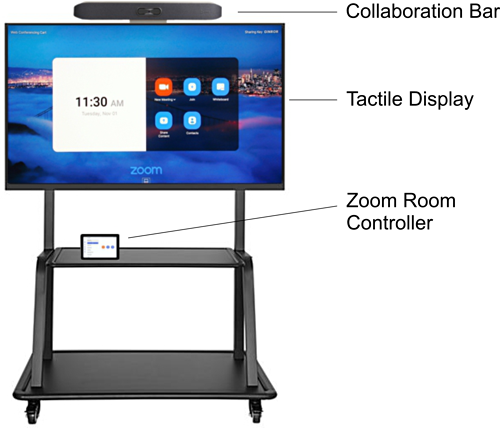
Technical Specifications and Manuals

- Stereo speakers
- Power Handling (RMS) 20 Watts
- Power Handling (MAX) 40 Watts
- Sensitivity 86.1 dB
- Smart camera
- 121° DFOV, 110° HFOV
- UHD 2160p (4K) capture resolution (Note: Zoom only supports 720p)
- 5x digital zoom
- Automatic group framing
- Automatic speaker framing
- Advanced microphone design
- Second order gradient microphones pick up all corners of the room with incredible clarity
- Beamforming
- 7.6m (25ft) pick up range
- Noise blocking innovations
- Keeps distracting noise and outside conversations from disrupting meeting with Poly NoiseBlockAI and Acoustic Fence
Manuals
Cart Concept
The Web Conferencing Cart integrates with existing audio-visual equipment without modification to an installation. In use, the cart is inserted between a podium's audio-visual cables and the presentation device (i.e., the content source) by connecting appropriate cables from the cart. A presenter who does not wish to use the cart is unaffected by its prior use, provided that cart has been disconnected from the podium.
Premise Prerequisites
The Web Conferencing Cart must be connected to a computer wired network LAN jack. (The InterZone assigned to the jack is not important.)
Overview of Cart Use
The following describes the general steps to follow to use the cart in a Zoom meeting. Detailed instructions are provided in the particular cart usage scenario, below.
Hosting a Zoom Meeting
- Identify the cart usage scenario that matches your intended use of the cart
- Create a Zoom meeting
- Invite the cart to participate in the meeting or know the meeting ID and passcode
- On premise, turn on the cart via the CyberPower UPS
- Remove the lens cap
- Connect the wires from the cart to existing A/V cables as per the chosen usage scenario
- Connect your computer to existing A/V cables as per the chosen usage scenario
- Launch the Zoom meeting
- Join the meeting from the cart
- Configure the Zoom meeting experience
- Hold the Zoom meeting
Invited to a Zoom Meeting
- Refer to the Zoom Remote Participation usage scenario
- On premise, turn on the cart via the CyberPower UPS
- Remove the lens cap
- Connect the wires from the cart to existing A/V cables as per the usage scenario
- Connect your computer to existing A/V cables as per the usage scenario
- Join the meeting from the cart
- Configure the Zoom meeting experience
After the meeting
- Turn off the cart via the CyberPower UPS
- Cover the lens in the collaboration bar with the lens cap cover
- Disconnect all wires from the cart and existing A/V installation
Cart Placement
The cart is best suited for 'face-to-face' meetings, where everyone on premise faces the cart.
In a hybrid teaching setting, where a lecturer stands facing students, and it is desirable for the cart camera to capture the lecturer and the entire class, a compromises must be made. Lecturers should plan to be seen by remote students in profile, as shown below. This is a limitation of using a system with one camera. Enabling the camera and microphone on the lecturer's computer is likely to resolve nothing, since the sensitivity of the cart microphone will cause Zoom to highlight the cart camera as the active speaker.
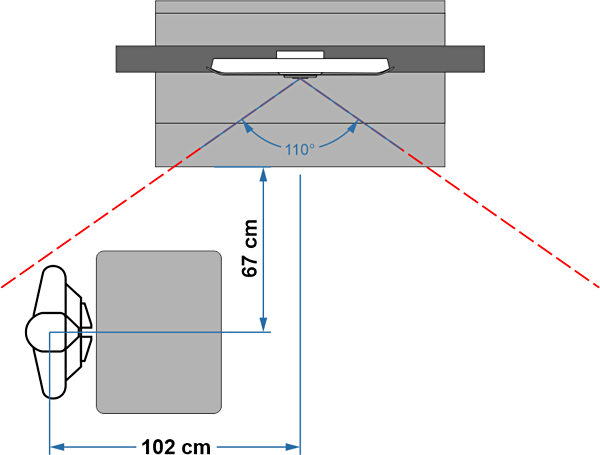
The permissible placement of the cart depends on the size of the classroom and the location of the classroom projector screen. In small classrooms, it is not possible to pull the cart back to view the class and the lecturer from a more frontal perspective. Also, when the tactile display is needed for annotation a lecturer must remain close to the display.
The above dimensions illustrate the proximity of the lecture podium to the cart for a lecturer to remain within the camera's field of view at close range. Cables between the the cart the the podium will require the lecturer to step to their right, walking around the podium, to reach the cart.
Use with Zoom meetings created within myCourses
Because the Web Conferencing Cart is associated with a non-McGill email address additional steps are required to allow the cart to join a Zoom meeting created within myCourses. Note that the cart cannot be made an alternate host because of licensing restrictions; someone with a McGill account must host the meeting.
Option 1: Meeting not yet created
To allow the cart to participate in a meeting prior to creating the meeting:
- Sign into the Zoom portal using your McGill email credentials
- Click on the Settings menu item
- Click Security under the Meetings tab
-
Disable the setting "Only authenticated meeting participants and webinar attendees can join meetings and webinars"
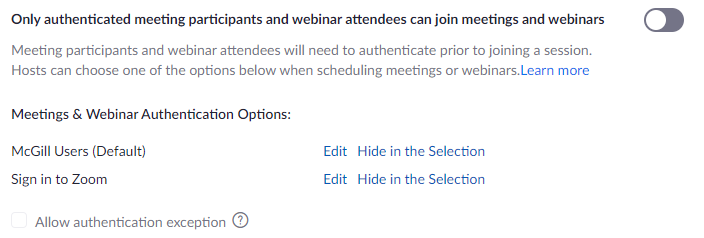
- Now create your meeting
Option 2: Meeting already created
If the meeting has already been created it can be modified to allow allow participants from outside of McGill. This can be done either via the Zoom portal or through myCourses. The steps below show how to proceed via myCourses assuming that the Zoom tool is visible in the navigation bar.
- Sign into myCourses and select a course
- Click on Zoom in the navigation bar
- Under the Upcoming Meetings tab click on the topic (Zoom meeting) to be modified
- Scroll to the bottom of the page and click on Edit this Meeting
- Scroll to the Security section and uncheck "Only authenticated users can join meetings"
Meeting Etiquette
The microphone can pick up a whisper at the back of a room as clear as a conversation nearby. As such, squeaky chairs and people tapping on table tops, for example, come across louder than speech. Attendees on premise should make a concerted effort to minimize extraneous sounds.
Usage Scenarios
The following illustrate common use cases. Select the one most suitable for your needs and adapt it if needed.
Zoom Remote Participation
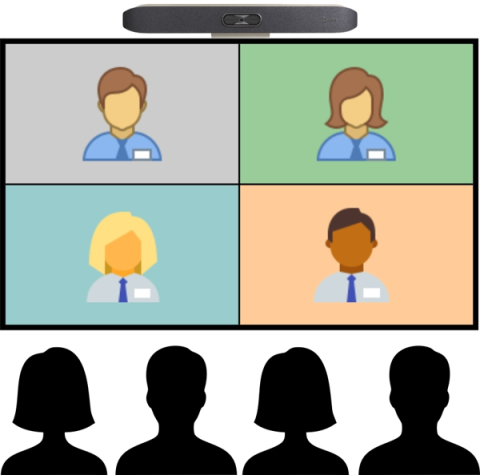
A small group of people in a room attending a meeting with remote participants.
Zoom Presentation: Single Display
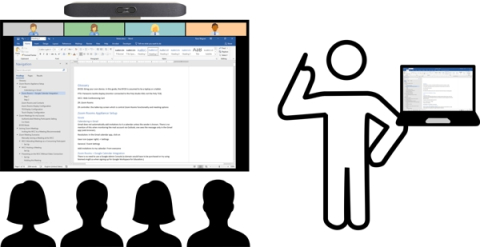
A hybrid presentation, whereby a presenter shares content on a single screen on their computer. Meeting participants are both on premise, with the presenter, and remotely attending.
Zoom Presentation: Extended Display
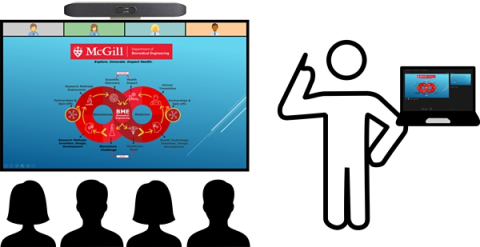
A hybrid presentation, whereby a presenter shares content from one of two screens extended on their computer. Meeting participants are both on premise, with the presenter, and remotely attending.
An example of this scenario is a Microsoft PowerPoint presentation.
Zoom Presentation: Extended Display + Projector
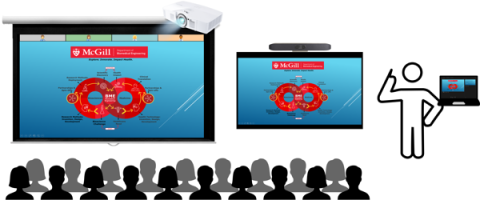
A hybrid presentation, whereby a presenter shares content from one of two screens extended on their computer. Meeting participants are both on premise, with the presenter, and remotely attending. This is akin to presenting with an extended display, but with shared content displayed on the tactile display and on the classroom projector.
An example of this scenario is a Microsoft PowerPoint presentation in front of a large audience on premise.
BYOD Extended Display
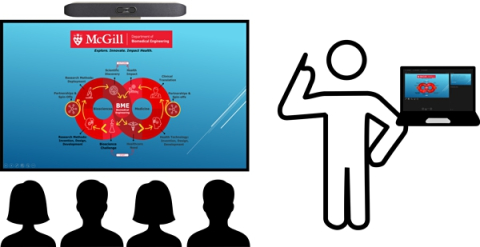
A small group of people attending an in-person presentation. This is not a web conferencing meeting. The presenter is using the tactile display as an extended monitor on their computer.
BYOD Passthrough
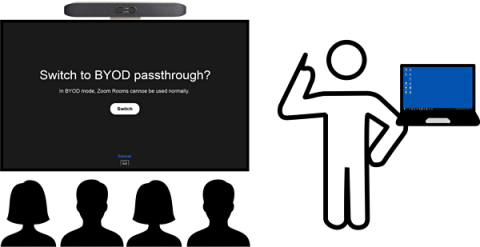
An on-line meeting other than Zoom, where the camera, microphone, and speaker in the collaboration bar are connected to the presentation laptop as distinct devices.